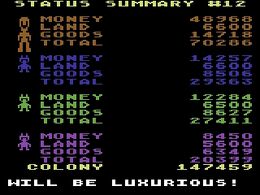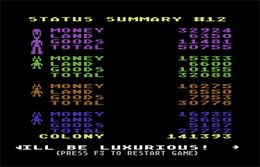M.U.L.E.
| M.U.L.E. | ||
|---|---|---|
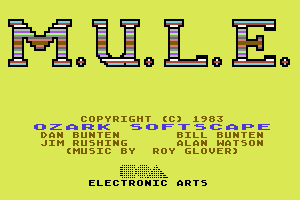 | ||
| Game No. | 69 | |
| Voting | 8.40 points, 57 votes | |
| Developer | Dan Bunten, Bill Bunten, Jim Rushing, Alan Watson | |
| Company | Ozark Softscape | |
| Publisher | Electronic Arts | |
| Musician | Roy Glover | |
| HVSC-File | GAMES/ M-R/ M_U_L_E.sid | |
| Release | 1983 | |
| Platform | C64, Atari 800, IBM PCjr, MSX-1, NES, PC-8801 MKII | |
| Genre | Strategy, Miscellaneous, Simulation | |
| Gamemode | Single player up to 4 players (in turns) up to 4 players (simultaneous) (during auctions) | |
| Operation | ||
| Media | ||
| Language | ||
Description[edit | edit source]
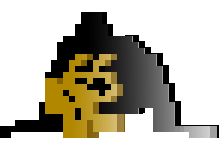 |
M.U.L.E. is a strategy build-up game by Ozark Softscape and Electronic Arts from 1983, initially developed for Atari 800 and later ported to C64 and further systems, with slight changes in the gameplay. The fascination of the game, especially in multi-player mode, is based on an elaborate game mechanics, a somewhat unpredictable course of events and an original scenario - colonization of a far-off planet by different space traveling species - as well as a high degree of interaction. Though contemporary critics praised the game, only about 30,000 copies were sold, a rather low figure compared to other early Electronic Arts titles like Seven Cities of Gold of which 150,000 copies were sold or "Pinball Construction Set" which was a commercial success with 300,000 sold copies. M.U.L.E. is regarded as an early archetype of original design, well-done balancing and interaction between the players. Will Wright, programmer of classics such as Raid on Bungeling Bay and Sim City once stated: "Ask most game designers what their favorite computer game of all time is and you'll get M.U.L.E. as an answer more often than any other title."[1] |
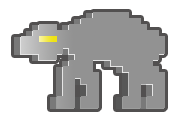
|
Course of the game[edit | edit source]
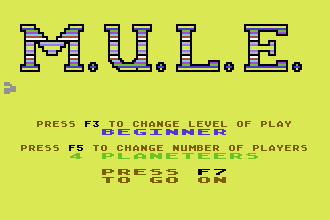
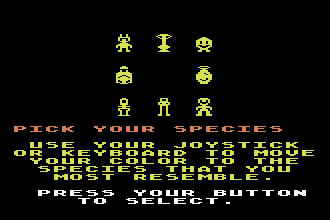
Up to 4 players can take part in a game at the same time. Your task is colonizing the planet IRATA (which is Atari read backwards) and in the course of doing so, controlling as much land, producing as much goods and making as much money as you can. The player who turns out to have performed best in these activities after the last round has ended, wins the game and is even declared "First Founder" if the total colony score based on all players' riches is high enough. The other players may congratulate the winner.
Each player plays the role of one of 4 settlers. If there are less than 4 human players, the remaining settlers are controlled by the computer. After a color has been picked (purple, blue, green, orange), one of 8 species must be chosen. The computer will always go for "Mechtron".
Beginners are recommended to choose the species "flapper" because it starts with $600 extra and more time to finish their turns. Experts pick "humanoid", starting with $400 less money and less time. By this method it is possible to provide beginners a fair chance in a game against experts. All the other species have the same amount of money and time, unless you play tournament mode in which computer players have $200 extra.
There are three modes:
Beginner
- The game ends after 6 rounds.
- Tradable goods: food, energy, smithore, price limits, unlimited amount of MULEs at fixed prices.
- All players are given extra resources and time.
Standard
- The game ends after 12 rounds.
- After the land distribution there can be land auctions, cursor moves faster in development stage and land auctions.
- Less resources and MULEs at unsteady prices without limits.
- Pirates can appear and steal Smithore.
Tournament
- Like Standard mode.
- Additional resource Crystite, cursor moves very fast in development stage and land auctions.
- Assay option to find out which squares are suitable to gain Crystite.
- Pirates steal all Crystite produced or stored.
Description of the map[edit | edit source]
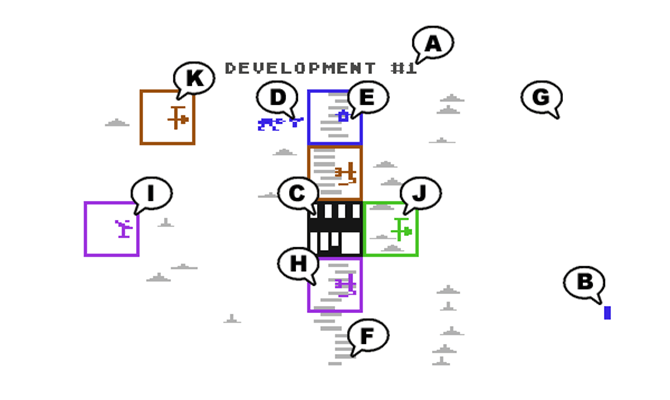
- A: Current stage of game, here: development stage of turn #1
- B: The time bar (time is almost up)
- C: The town in which each player begins the development stage in order to buy and equip MULEs
- D: The own settler character, here dragging a MULE to an empty river tile
- E: An own empty tile waiting for a MULE
- F: The river, best tile to produce food. On river tiles, mining is impossible
- G: Plains, suitable for energy MULEs
- H: A river tile, already occupied by a food MULE of another player
- I: A plain tile, already occupied by an energy MULE of another player
- J: A mountain tile, already occupied by a Smithore mining MULE of another player
K: Bad example: Mining on plain tiles is not very effective
Land grant, Auctions and Development[edit | edit source]
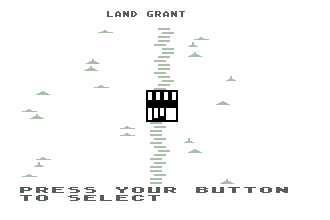
At the beginning of a round, 4 of the 44 tiles of which the map consists, are distributed. A frame moves from tile to tile (called 'plots' in the game). Who pushes the button first, will get the tile. If you did not push at all, you leave the land grant empty-handed and may complain a lot about a malfunctioning joystick or invent other excuses.
After the land grant up to 5 (at most times only 1 or 2) tiles are sold in an auction to the successful bidder. If the currently offered tile is not sold, the auction is over, no further plots are sold in this round.
The most important unit for the settlers are the M.U.L.E.s ![]() . This acronym stands for Multiple Use Labor Element, but reads like the animal for a reason - MULEs can be very stubborn, refuse work or run away. They are sold at the beginning of a turn in the town in the middle of the playing field, equipped for a certain task/resource, led to an empty tile and then installed via fire button. For doing so, the player must move the own figure (NOT the MULE) to the house in the middle of the plot, otherwise the MULE runs away. Already installed MULEs can be moved to other empty tiles or led back into the town for selling or changing the equipment.
. This acronym stands for Multiple Use Labor Element, but reads like the animal for a reason - MULEs can be very stubborn, refuse work or run away. They are sold at the beginning of a turn in the town in the middle of the playing field, equipped for a certain task/resource, led to an empty tile and then installed via fire button. For doing so, the player must move the own figure (NOT the MULE) to the house in the middle of the plot, otherwise the MULE runs away. Already installed MULEs can be moved to other empty tiles or led back into the town for selling or changing the equipment.
In this development stage each player plays on their own, while the others must watch but may provide helpful advice, threats or sardonic comments.
First a MULE needs to be bought in the town, then it needs to be equipped for gaining resources on an empty plot of the player.
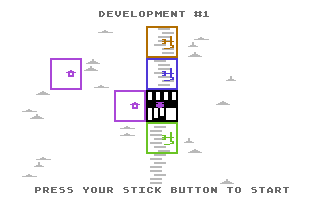
The fast shrinking time bar in the right hurries the players to make decisions - or mistakes which frequently happen while acting under time pressure. If the bar has run down, the player's development is over. MULEs not installed in time run away and nothing happens on the plot which will lead to much approval of the other players.
A player can also finish his turn voluntarily by moving his figure into the "pub" in the town to win some dollars by gambling. The amount of money you win depends on how much time was left on the time bar but also increases from round to round, the total maximum is $250 in round 12 if you instantly enter the pub.
The time bar shrinks twice as fast if you do not move your figure.
Resources and their meaning in the game[edit | edit source]
Resources are produced or consumed in the production stage. In the trading stage, any surplus can be sold to other players or the "store" of the town in order to get more money to buy land, MULEs or other resources you need (i.e. food, energy). Unlike other players, the store has unlimited money and keeps all goods it buys, just to sell them at exorbitant prices to the players again next round. The price of a resource is determined via supply and demand and availability: Prices for rare goods rise, while prices for other goods move around some standard level. The sum of the players' and the store's supplies determines the price development. That is why meanwhile events which reduce food production makes the food price explode while energy boosting events can make the energy price crash.
Note: The game ends instantly and declares the defeat of all players if neither players nor the store have any food or energy units at the end of a turn.
Food is best produced in river tiles, plains are also okay. It is needed to grant maximum playing time during the equipment stage. At the beginning 3 units are enough for that. Later the required minimum increases. One unit insufficient food leads to slightly reduced playing time (about 25%), 2 units shortfall already mean a significant handicap (66% reduced playing time). With even bigger shortcomings you are lucky if you have enough time to enter the pub. Half of the food you did not consume in a turn will "spoil". A player without any food can not do anything in the turn, which is a real disadvantage, especially in early game.
Normal price: $50 (Buy from Store), $15 (Sell to Store)
Energy MULEs are best located in plains (tiles looking "empty"), river tiles also work, though. Energy is needed to power MULEs: No energy, no production. For every non-energy MULE (food, ore, crystite) you must produce 1 energy unit. Shortcomings lead to total production outage of a randomly chosen MULE per unit. Like food, energy also "spoils" if neither used nor sold. In the course of the game, energy shortages are more serious than lack of food, because of the negative impact on your production. Worst case scenario is a food shortage due to energy shortage.
Normal Price: $45 (Buy from Store), $10 (Sell to Store)
Smithore is a metal that serves two purposes: first, it is a mediocre good, but a reliable source of income (as opposed to Crystite which price is determined by chance), and can be stolen by pirates. Secondly the store requires Smithore to fill up its MULE stock. To build a new MULE two units of Smithore are needed. If not enough units are resupplied the price of the remaining MULEs explodes within a few rounds and can, in the worst case, reach the 1000$ mark. A player can store a maximum 50 units of smithore, all exceeding units are spoiled. Ideal plots for the mining for smithore are tiles with as many mountains as possible. No mining are allowed in the Rivervalley.
Normal Price: $85 (Buy from Store), $50 (Sell to Store)
Crystite only appears in tournament mode. With an average prive of $100, crystite tops any other resource and has no meaning apart from being sold to the store for off-world export, thus players cannot buy Crystite from the store for investment purposes. The problem is that it is not clear at the beginning which tiles are appropriate for producing crystite, so you must either try your luck or go to the assay office to find out. Moreover, crystite stocks are always a potential target for the pirates stealing all the existing crystite units in the game. Also the price range behaves rather wildly as it is calculated randomly and not by supply and demand like the other resources. Like smithore, crystite cannot be mined on river tiles.
Normal Price: $50-150, average $100 (Sell to Store)
Distribution and Localisation of Crystite
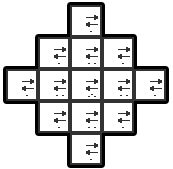
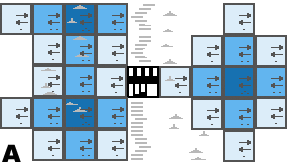
Particularly interesting are the examples marked as F: Those are mega clusters with all crystite locations close to one another and G: two "high" productivity tiles were generated on the river and the third directly under the town.
Whereas food, energy and smithore have clear tile types for optimum production, crystite productivity can not be seen at the beginning of the game.
Finding out about crystite sources requires visiting the assay institute in the town, running to the centre of a plit and then pushing fire button. The dialogue "Sample ready to return to office" appears. After returning to the assay office, you are informed if the tile has "high", "medium", "low" or "no" crystite resources.
- The distribution of the crystite sources always follows a certain pattern. Three "high" tiles are placed randomly, however, it is possible that those are river tiles, inaccessible to mining.
It is also possible that a "high" tile is placed directly under the town and is inaccessible as well.
- Any "high" productivity tile is surrounded by "medium" tiles which are surrounded by "low" tiles on both X and Y axes.
- If two clusters are generated too close to one another, an overlay effect can cause surprises as shown in the graphics on the right. The limits of the map also mark an end of a cluster.
- All of the four river tiles are automatically set "high", but not surrounded by "medium", unless the random distribution creates a high field directly on a river tile.
- Instead of using the assay office, you can also just equip a MULE for crystite mining and try your luck. In the next production stage the productivity is displayed.
If you are smart, you can also deduce the distribution by the assays of the other players.
Catch the Wampus![edit | edit source]
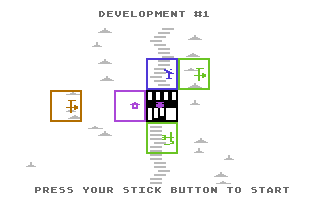
The Cave Wampus is a native life form on Irata. It lives in the canyons of the hills and mountains. As it is afraid of MULEs, it only appears when the player is walking around alone. A dark pixel representing the Wampus appears in irregular intervals on random mountain tiles and stays there only for a couple of seconds, before it appears on another mountain. It makes a sound by which skilled hunters know about its Y-position on the map. If you manage to reach that pixel on time, you catch the Wampus and get a chest with money as ransom. In the first three turns you get $100, from round 4-7 $200, from 8-11 $300 and in the very last turn $400. Human players can catch the Wampus once per round.
Description of the Town[edit | edit source]
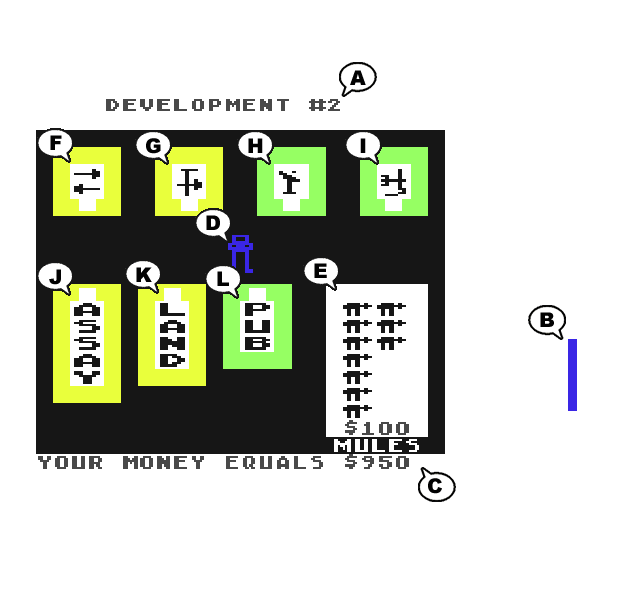
- A: Current stage of game, here: development stage of 2nd round
- B: Time bar
- C: Remaining money in dollars
- D: Player figure, here: a "Leggite", front view
- E: MULE enclosure. Here you can buy MULEs for the displayed price and later equip them for a certain type of resources. Only then you can leave the town with the MULE.
- F: Crystite mining equipment, price 100$.
- G: Smithore mining equipment, price 75$.
- H: Energy production equipment, price 50$.
- I: Food production equipment, price 25$.
- J: Assay office to locate crystite. Can only be entered without MULE. Move player figure to middle of a tile, click fire and come back here. Then you are informed how much crystite can be produced ("no", "low", "medium" or "high"). The service is free.
- K: If you want to sell one of your tiles in the next land auction, you have to enter this building, move the player figure to the middle of the tile to be sold and click fire. After the next land grant the tile is auctioned off.
- L: Pub. Here you can end your turn and earn some money, dependent from remaining time (i.e. size of time bar).
Random Events[edit | edit source]
Random events during the game can be curse or blessing. There are two kinds:
- Player-specific events: Events happening with a probability of 25% and being displayed before a player's turn, in most cases it means a gain or loss of money. Sometimes, though, these events are more fatal, e.g. loss of a land tile. With one exception, the single events only occur once per game.
| Event |
|---|
| YOU JUST RECEIVED A PACKAGE FROM YOUR HOME-WORLD RELATIVES CONTAINING 3 FOOD AND 2 ENERGY UNITS. |
| A WANDERING SPACE TRAVELER REPAID YOUR HOSPITALITY BY LEAVING TWO BARS OF SMITHORE. |
| YOUR MULE WAS JUDGED "BEST BUILT" AT THE COLONY FAIR. YOU WON ?$ |
| YOUR MULE WON THE COLONY TAP-DANCING CONTEST. YOU COLLECTED $?. |
| THE COLONY COUNCIL FOR AGRICULTURE AWARDED YOU $? FOR EACH FOOD PLOT YOU HAVE DEVELOPED. THE TOTAL GRANT IS $?. |
| THE COLONY AWARDED YOU $? FOR STOPPING THE WART WORM INFESTATION. |
| THE MUSEUM BOUGHT YOUR ANTIQUE PERSONAL COMPUTER FOR $?. |
| YOU WON THE COLONY SWAMP EEL EATING CONTEST AND COLLECTED $?. (YUCK!) |
| A CHARITY FROM YOUR HOME-WORLD TOOK PITY ON YOU AND SENT $?. |
| YOUR OFFWORLD INVESTMENTS IN ARTIFICIAL DUMBNESS PAID $? IN DIVIDENDS. |
| A DISTANT RELATIVE DIED AND LEFT YOU A VAST FORTUNE. BUT AFTER TAXES YOU ONLY GOT $?. |
| YOU FOUND A DEAD MOOSE RAT AND SOLD THE HIDE FOR $?. |
| YOU RECEIVED AN EXTRA PLOT OF LAND TO ENCOURAGE COLONY DEVELOPMENT. |
| MISCHIEVOUS GLAC-ELVES BROKE INTO YOUR STORAGE SHED AND STOLE HALF YOUR FOOD. |
| ONE OF YOUR MULES LOST A BOLT. REPAIRS COST YOU $?. |
| YOUR MINING MULES HAVE DETERIORATED FROM HEAVY USE AND COST $? EACH TO REPAIR. THE TOTAL COST IS $?. |
| THE SOLAR COLLECTORS ON YOUR ENERGY MULES ARE DIRTY. CLEANING COST YOU $? EACH FOR A TOTAL OF $?. |
| YOUR SPACE GYPSY INLAWS MADE A MESS OF THE TOWN. IT COST YOU $? TO CLEAN IT UP. |
| FLYING CAT-BUGS ATE THE ROOF OFF YOUR HOUSE. REPAIRS COST $?. |
| YOU LOST $? BETTING ON THE TWO-LEGGED KAZINGA RACES. |
| YOUR CHILD WAS BITTEN BY A BAT LIZARD AND THE HOSPITAL BILL COST YOU $?. |
| YOU LOST A PLOT OF LAND BECAUSE THE CLAIM WAS NOT RECORDED. |
- Global events: Events displayed graphically before or after production stage. These events concern all players.
Only in rare cases nothing happens. In round 12 the global event is always return of colony ship.
| Event | Probability | max occurence | Effect |
|---|---|---|---|
| Planetquake | 15% | 3 times | All mining MULEs produce only 50%. |
| Pest Attack | 15% | 3 times | one of the two leading players loses food production on a randomly chosen tile. |
| Sunspot Activity | 15% | 3 times | All energy MULEs produce extra energy. |
| Acid Rain Storm | 15% | 3 times | All food MULEs produce extra food. All energy MULEs produce less than normal. Increased effect on tiles that are touched by the cloud. |
| Fire in Store | 10% | 2 times | All supplies of the stores are destroyed. Nothing can be bought at the store in this round. |
| Meteorite Strike | 10% | 2 times | A Meteorite smashes a randomly picked MULE and grants the tile "high" crystite production. |
| Radiation | 10% | 2 times | A randomly picked MULE of one player ranked two or three goes crazy and runs away! |
| Pirate Ship | 10% | 2 times | The complete smithore (standard game) or crystite (tournament) production and storage are stolen. |
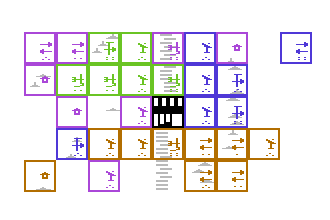
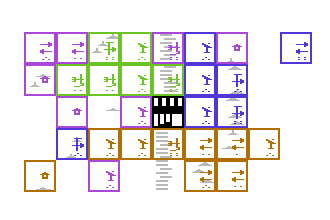
production, but reduces energy production.
Production stage[edit | edit source]
After all players completed the development stage, the installed MULEs begin producing resources. Each MULE can in theory produce up to 8 units of a resource type. The real production depends on four decisive factors:
- I) Quality of tile:
Food is best produced on river tiles, energy in plains and smithore in tiles with as many hills as possible.
The quality of a tile is displayed by up to four dots beneath the resource symbol of the tile, after development stage is over.
Four dots indicate a "high" quality, whereas no dots mean "totally inadequate", which can only happen in crystite mining on "no crystite" tiles, however.
Excellent tiles produce three to four units of a resource by average, poor tiles normally produce nothing at all.
- II) "Economies of scale"
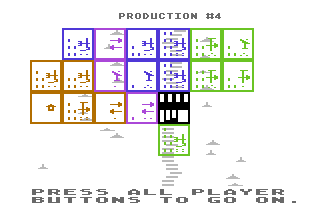
If a player produces the same resource type on neighboring tiles (on X or Y axis, diagonal neighboring does not work), the production is increased by one per tile. This bonus counts in addition to factor III.
In the picture on the right it is made clear: The blue player has three neighboring food tiles which produced accordingly well. The same can be seen at the smithore production of the green player on three neighboring tiles.
- III) "Learning curve theory"
As soon as a player produced the same resource on three (6/9/12/etc) tiles, the production is increased by one on all the three tiles, no matter if they are neighboring or not. This production bonus counts in addition to factor II.
- IV) Energy:
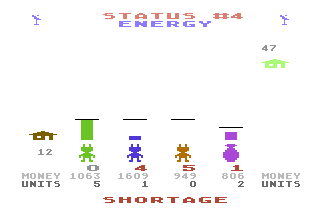
If a player has too little energy units, the production of one randomly picked (non-energy) tile per lacking energy unit is cancelled and produces nothing in this turn.
Trading Stage[edit | edit source]

In the trading stage there are auctions for each resource type, always in the order: Smithore, Crystite, Food, Energy. If no surplus of the resource in question is for sale, the auction is skipped with the dialogue "no sellers, no auction". If no player has a single unit of the resource, the auction is skipped completely, e.g. if at an early stage of game no one has started crystite mining yet.
The produced units are displayed as growing bars. Food and energy consumption are subtracted, 50% of the remaining surplus can "spoil". Then a minimum line is displayed, indicating surplus or shortage of food and energy.
At the beginning of every auction the players can decide if they want to be sellers or buyers. The local store is both buyer and seller and determines price maximum and minimum. However, the store can only sell as many units as have been sold to it in preceding rounds. So it can be profitable not to sell certain resources for a couple of rounds to boost the price.
The players can now move their figures towards eachother, depending on whether they want to sell or buy. Once the lines of two figures touch, they have a deal at the displayed price and they trade units of the resource until either one player removes his figure or the buyer has run out of money or the seller has run out of resources.
If food or energy are traded, the seller is automatically placed back to the top of screen when he reached the "critical level", i.e. the amount he needs himself.
"Collusion":
Two human players can push the fire button at the same time in order to unite against AI players by excluding them and deal in private in the "collusion" mode.
End of round[edit | edit source]
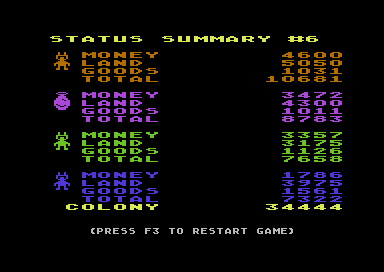
After the last auction is over, the figures march into the status summary screen in the order of ther current score.
Score is calculated as follows:
- Money: current money in $
- Land: 500 points per land tile on the map + cost for MULEs and their equipment
- Goods: current market vaulue of all resources in $. In critical times these values can vary a great deal.
If a resource is rare, this is indicated by a scroll stating: "The colony has a shortage of....".
Meaning of ranking for course of game:
- The leading player won't experience any positive random events, but is more likely to become victim of negative ones such as vermin, radiation etc.
- The further behind a player is ranked, the more he is favored in land grant and auctions, i.e. if more than one player select a tile at the same time, the one with the worst ranking will get the tile. Also, rank 4 is always the first who can place a bid in auctions which is very helpful if resources are rare.
End of game[edit | edit source]
| Colony Score | Ending | Rating |
|---|---|---|
| <20.000 | Prison ending | Overall, the colony failed...dismally. The Federation debtors' prison is your new home! |
| 20.000 | On your own ending | Overall, the colony failed...The Federation will no longer send trade ships. You are on your own! |
| 40.000 | Tent ending | Overall, the colony survived...barely. You will be living in tents. Few trading ships will come your way! |
| 60.000 | Bare minimum ending | Overall, the colony was a success. You have met the minimum standards set by the Federation, but your life will not be easy! |
| 80.000 | Comfortable ending | Overall, the colony succeeded. The Federation is pleased by your efforts. You will live comfortably! |
| 100.000 | Elegant ending | Overall, the colony succeeded...extremely well. You can now retire in elegant estates! |
| 120.000 | Luxury ending | Overall, the colony delighted the Federation with your exceptional achievement. Your retirement will be luxurious! |
The player who made the biggest fortune, i.e. land, resources and money, is the winner.
The sum of the individual player scores results in the "Colony Score" which will influence the opinion of the Federation and the future living conditions on Irata.
If a colony score of 60,000 or more is reached, the colony is rated as a success and the winning player is declared "First Founder" and his figure's sprite is stretched to match his boosted ego.
A colony score higher than 120,000 is really rare and highly dependent on random events.
Design[edit | edit source]
Graphics: Apart from the intro M.U.L.E. comes along with very plain blocky graphics without frills. Accordingly, very simple symbols for resources and a large font for messages contribute to clearness throughout the game. Unfortunately also the animation consists of only three frames per figure.
Sound: The groovy intro music with the typical stomping beat and the jolly fanfare also appears ingame in the overwiew after each round. Short jingles and fanfares during the game ("Charge!", "Lied der Wolgaschlepper") highlight positive or negative meanwhiles and the end of the players' turns. Moreover, there is a variety of strange SFX like the sizzling of acid clouds, earth quakes or comet impacts.
Hints[edit | edit source]
Controls[edit | edit source]
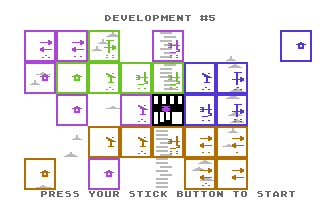
 - to abort the intro, press the fire button
- to abort the intro, press the fire button- F3 - to choose the beginner, standard or tournament version
- F5 - to set the number of players from 0 to 4. (When choosing 0, the computer plays a demonstration game, missing players are substituted by the computer).
- F7 - to start the game.
In the game
- F1 - to pause the game or to restart the intro and the choice of character
 - speed up computer player.
- speed up computer player.
- You need at least one joystick to play M.U.L.E. When playing with two or more players, up to two players will use the keyboard during the action phases. The following keys are used:
- Left keyboard player: Q - "up", C= - "down"
Right keyboard player: ^ - "up", = - "down"
Both players: both keys - fire button
- During the Development Round the players can use any available joystick.
Tips[edit | edit source]
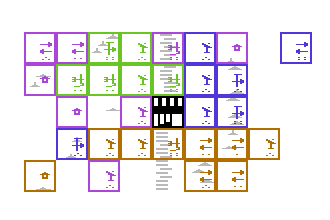
- Try to get tiles connected to eachother instead of spreading your estate all over the planet.
- Increase production by producing the same resource type on neighboring tiles.
- Increase production by producing the same resource on at least 3/6/9/etc. tiles.
- Do not sell any resources in the final round, it is not profitable.
- Try to equip all your land with MULEs as soon as possible. Don't enter the pub before you have made sure, no further MULE can be installed.
- Only hunt the Wampus if no more tiles are to be equipped.
- At the beginning of the game, it can even be helpful to be ranked 3rd or even 4th, as you will be privileged in auctions and random events.
- Look careful if other players assay. With some brains, you can easily determine profitable crystite sites.
Solution[edit | edit source]
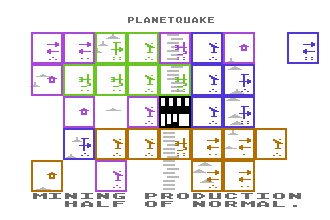
Successful game with one Humanoid player versus 3 computer players in tournament mode
- First make up your mind if you really need a river tile for your food supply. Though it normally produces enough food for the whole game, it can not be used for mining. Buying food from computer players might make sense.
- Crystite mining is normally the safest way to make money. Computer players tend to focus on smithore and will only shift that strategy if they get profitable crystite tiles.
- If you fail to get profitable crystite tiles, the synergy effect of neighboring crystite production can compensate for the tiles' quality.
- If your plan is making money by selling food and energy, make sure to produce enough to supply yourself and all the computer players to prevent them from shifting their production to energy or food.

- In order to boost food and energy prices, you might want to create shortages by buying all the units available in the store plus the units the computer players want to sell to the store.
- As a seller, you should wait till the computer players have emptied the store, for only then you can demand almost any price you like, unless they could cover their demand completely in the store.
- Do not be too greedy. Selling many units at a good price is better than selling only some at an exorbitant price. Keep the colony score in mind when you squeeze money out of your rivals!
- In land auctions, consider whether the price is justified by future production of the tile.
Please post any comments regarding the solution in Talk:M.U.L.E.
Cheats[edit | edit source]
None known.
Voting[edit | edit source]
| Voting of the C64-Wiki-User (10=the best vote): | ||
| 8.40 points at 57 votes (rank 34). You need to be logged in to cast a vote. | ||
| C64Games | 10 | 22nd May 2006 - "Highlight" 4869 downs |
| C64.com | 8,5 | 29th December 2006 - 2545 downs |
| Lemon64 | 8.6 | 5th December 2001 - 108 votes |
| Rombach | 10 | September 1984 - Vote 1 "Crème de la Crème" |
| Gamebase64 | 10 | 12th June 2005 - "A Classic!" |
| Kultboy.com | 9,5 | 28th July 2008 - 4 votes |
| ZZap64 | 81% | Edition 85/06 |
Reviews[edit | edit source]
Pascal Ciampi: "The best computer game at all". "The simple basic principle of an economic game, which is that demand and supply set the price, form the basis of this game idea. An when this is played with four people on one computer - which itself is rather seldom for a computer game - a bit of psychology adds. Furthermore it is designed with much love for details, still today I like listening to the intros and jingles and here and there you can find small quotes to the computer (games) world of that time. Source: Interview with Pascal Ciampi "
Sledgie: "The game is much fun to me. Due to the three levels and the possibility to play with several humanoid players it is very diversified. Conclusion: a very simple, very good economic simulation."
Sid Meier: "best game ever."
Ken Rosman (former Black Isle Studios): "M.U.L.E. is just one of those great games that you can play over and over again and it is different every time. Plus it was one of the original great multiplayer games."
Warren Spector (Ion Storm): "Single-player, this game was swell. With other people, it was transcendent. [...] You don't even have to upgrade the graphics. They're simple, iconic and fun just the way they are. Heck, even the music was fun (and I bet you can all hum along with me right now!)."
Chris Crawford: "Dan Bunten created the best computer game design of all time: M.U.L.E."
Brian Moriarty: It is required study for anyone interested in the design of multiplayer computer games."
Will Wright (Maxis): "Ask most game designers what their favorite computer game of all time is and you'll get M.U.L.E. as an answer more often than any other title."
John Gorenfeld: "Bunten's greatest game, and the one with the most relevance to today's multiplayer world, was M.U.L.E."
Rick Johnson (Raven Software): "Top 10 Games of All Time:
- M.U.L.E. (C64)
- Warcraft 2 (PC)
- Doom (PC)
- Dungeon Master (Amiga)
- Lemmings (Amiga)
- Empire Deluxe (Amiga)
- Fairy Tale Adventure (Amiga)
- Bard's Tale (C64 / Amiga)
- Populous (Amiga)
- Dungeon Keeper (PC)"
Worf: "M.U.L.E. is a great economic game, where you fathom the planet Irata with a maximum of 4 persons. You can practice agriculture, energy industry and two types of mines. After one more or less successful year you can trade with the goods, which is designed particularly nicely and stirs the blood of traders. I don't know any other game, that points up the forming of the price by demand and supply and the power of monopolists as lovely as this. M.U.L.E. surely is very high up in my personal top 10 of trading games, of computer games for the C64 altogether in the top 100."
TheKills: "For beginners very difficult, but it gets rather funny after some time. But as I never really got warm with this game, I can only give 7 points."
Blubarju: "I have played M.U.L.E. over Netplay (with WinVICE) with a friend a short time ago. The fascination is still as it was in the 80s. A real evergreen on the C64 and therefore there can only be the 10 points."
Robotron2084: "With four human players begrudging each other the very air they breathe, M.U.L.E. is huge fun. The well-balanced design, combined with random events and the many tactical options grant a high level of variation. In such games I witnessed people interact wildly, loudly or even a little violently. This game is an absolute jewel which I associate with wonderful memories of cutthroat haggling in front of the monitor and which keeps entertaining me also in single player mode. 10 out of 10 points!"
Miscellaneous[edit | edit source]
Trivia[edit | edit source]

- An episode of the science fiction novel "Time enough for Love" by Robert A. Heinlein inspired Dan and Bill Bunten to create M.U.L.E.
The chapter "The Tale of the adopted Daughter" tells how he immortal protagonist Lazarus Long and his wife Dora lead a trading colony on a distant planet. In doing so, they use genatically enhanced mules who produce energy. Though they succeed in making the initially struggling colony finally prosper, before the colony ship returns, Dora's death makes the episode end tragically, leaving her immortal husband back alone and full of grief.
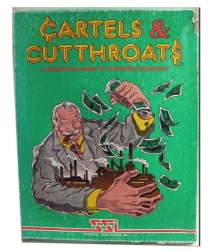
- Originally the title was supposed to be named "Planet Pioneers" and was planned to be a mix of Dan Bunten's earlier simulation "Cartels & Cutthroats" and action sequences of his war game "Zytron Masters", both of which published by SSI for Apple II.
Electronic Arts' idea of naming the game "Moguls from Mars" was not realized as the developers presented the finished intro with the acronym M.U.L.E. just in time.
A toy AT-AT from Star Wars II belonging to coder Alan Watson's son was inspiration for the M.U.L.E. sprite, after the laser guns were removed in favor of the classic casual M.U.L.E. walk animation.
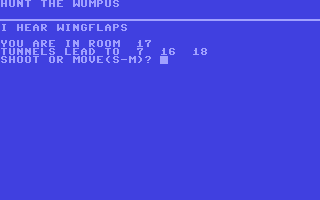
- The Wampus hunt has its origin in the text only game "Hunt the Wumpus" by Gregory Yob, published in the US american "Creative Computing Magazine" in 1975.
The aim of that game is to follow Wumpus in its cave without being eaten or falling into a bottomless pit.
The game is also available for the C64 in several versions.
- Atari vs. C64-Version
- On Atari the planet quake destroys all MULEs!
- On Atari it is possible to boost the prices almost unlimitedly by buying resources in the final round.
- In the C64 Version it is impossible to catch the Wampus in the very first line of the screen. It also moves more frequently and randomly than in the Atari version.
- The movement speed some of the figures varies a great deal in the Atari version.
- In the C64 version a player figure needs two instead of one steps to reach the bar of the price offer from the default position.
- It is controversially discussed whether the Atari version creates completely random maps (as the C64 version definitely does) or picks randomly from a set of 128 predefined maps.
- Providing four joystick ports, Atari 400/800 systems allowed four players to play with four joysticks, whereas in a four player game of the original C64 version, two players had to use keyboard controls in the auctions, and "borrowed" a joystick during the single-player parts of the game.
- In the Adventure Construction Set, another Electronic Arts release, there is a predefined scenario, in which the player's objective consists of shipping a load of "Crystite" from planet Irata to save a star fleet that run out of fuel.
Versions[edit | edit source]
- Peiselulli version from 2011 supports the 4 player joystick adapter. To emulate the 4-player interface in VICE, you need to activate it in "Settings" -> "Userport joystick settings" and choose "CGA Userport Joystick Adapter".
Cover[edit | edit source]
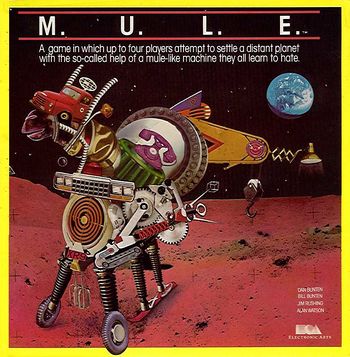 |
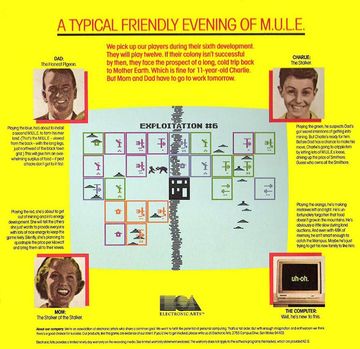 |
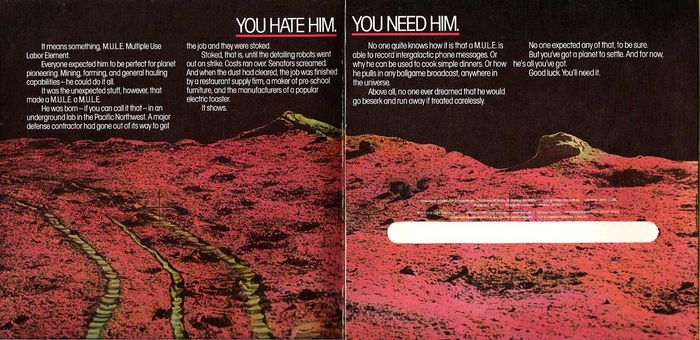 |
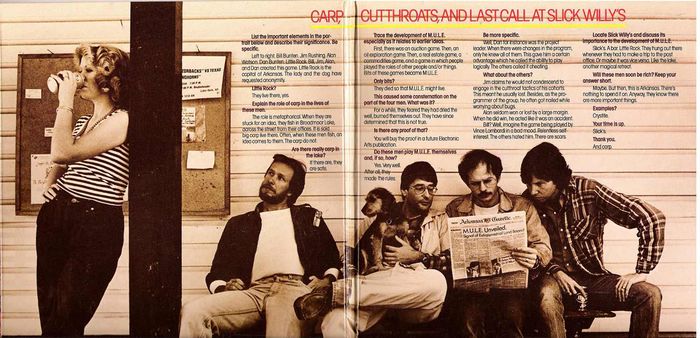 |
Video[edit | edit source]
References[edit | edit source]
Highscore[edit | edit source]
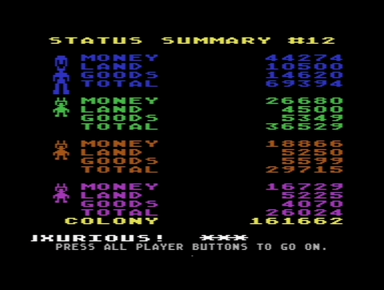
- Víctor Chaves - 69394 / 161.662 Colony (20.10.2025)
- Volker Conrath - 70.286 / 147.459 Colony (14.11.2010)
- Honko - 50.755 / 141.393 Colony (30.11.2007)
- Regecide - 39.822 / 121.919 Colony (07.04.2010)
- Robotron2084 - 33.876 / 108.828 Colony (09.11.2006)
- Futureman - 43.937 / 100.248 Colony (25.05.2008)
- Rules: Only scores that were achieved in the tournament mode with humanoids are counted. The score of the colony also counts, so that with several entries, there can be two highscore lists.
Links[edit | edit source]
| Wikipedia: M.U.L.E. |
- C64Games.de - Game No. 479
- Lemon64 - Game No. 1558
- Gamebase64.com - Game No. 5076
- C64.com - Game No. 451
- Test Report No. 1173 on Kultboy.com

- ZZap64 test report
- CSDb - Release No. 101455 (Peiselulli version for the 4 Player Interface by Protovision)
- Manual (PDF, 3.3 MB,
 )
) - World of M.U.L.E.
- M.U.L.E. Tournament page
- M.U.L.E. from the point of view of an ecomony teacher (Blog article
 )
)










